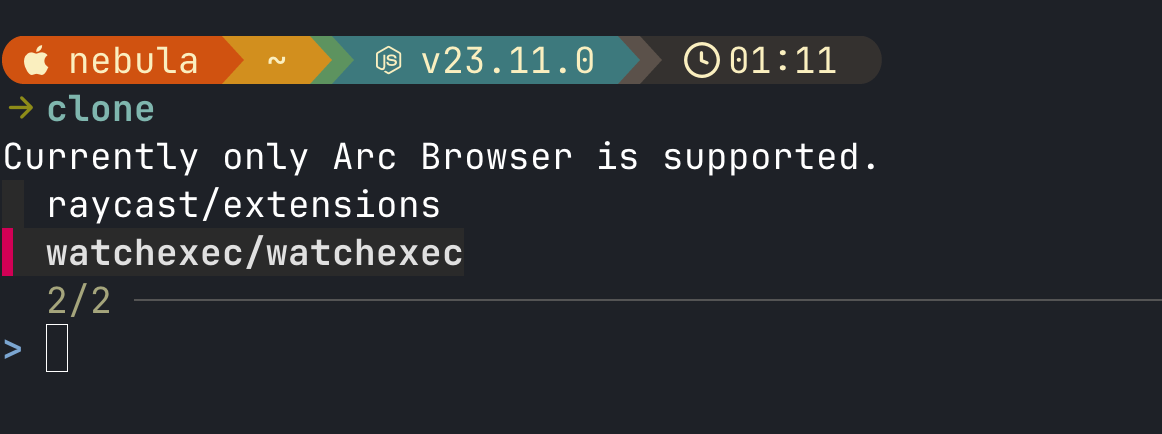全文的脚本都是
nushell的脚本,这可能是 Shell Script 中可读性最强的了。你也可以自己编写其它脚本。
前面的博文提到我是一个实用主义的人,但同时我也是一个懒人😂。我经常需要克隆一个仓库,git clone + url的命令似乎有点太长。我想写一个自定义命令clone,它足够灵活,可以接收六种参数:
- 空参。此时它会向我的浏览器 Arc 中查找打开的所有 GitHub 页面,然后打开 fzf 交互式选择器让我选择其中之一。
- 接收一个仓库的 url。它会解析出 owner 和 repo,然后执行
gh repo clone owner/repo。 - 接收一个
gh cli登录账号本人的仓库名。(格式!repo)。此时它的行为和gh repo clone一样。 - 接收一个命名空间下的仓库名(格式
owner/repo)。此时它的行为和git clone一样。 - 接收一个作者名(格式
@owner)。此时它会查询该作者的所有仓库,并打开 fzf 交互式选择器让我选择其中之一。 - 接收一个纯仓库名。此时它会查询此仓库名,并打开 fzf 交互式选择器让我选择其中之一。
克隆仓库之后,可以自动cd到该仓库的目录下。
最有意思的其实是第一个。我会放在最后讲我是怎么实现的。
解析url #
git clone只接受一个标准的远程仓库地址,但我们通常可能会进到一个GitHub的页面,它未必是该仓库的首页(如https://github.com/watchexec/watchexec/issues/525),此时`git clone`会报错:
$ git clone https://github.com/watchexec/watchexec/issues/525
Cloning into '525'...
remote: Not Found
fatal: repository 'https://github.com/watchexec/watchexec/issues/525/' not found所以我们可以编写一个使用正则的函数来从url中解析出仓库全名(owner/repo格式):
def parse-url [url: string] {
$url
| parse --regex 'http[s]?\://github.com/(?P<owner>.*?)/(?P<repo>.*?)/.*'
| first
| ($in.owner + "/" + $in.repo)
}可以注意到我们又使用了正则表达式的捕获组特性(在 这篇 博文中也提到过)。.*?中的问号表示非贪婪匹配,表示我们想匹配尽量少的字符,一遇到/就停止匹配。
url, !repo, owner/repo #
编写一个简单的辅助函数:
def clone-and-cd --env [fullName: string] {
gh repo clone $fullName
cd ($fullName | str substring (($fullName | str index-of "/") + 1)..)
}这样对于很多种情况,只要我们转换成fullName(owner/repo格式)就可以直接调用这个函数,实现了代码的复用。
export def clone --env [
name?: string # allow 4 kinds of input: url, owner/repo, @owner, repo
] {
if $name == null {
# TODO
} else if ($name =~ 'http[s]?\://github.com/.*') {
# Format: url, allow sub-url of the repo
clone-and-cd (parse-url $name)
} else if ($name | str contains "!") {
# Format: !repo, owner is current user of gh
gh repo clone ($name | str replace "!" "")
cd ($name | str replace "!" "")
} else if ($name | str contains "/") {
# Format: owner/repo
clone-and-cd $name
} else if ($name | str contains "@") {
# Format: @owner
# TODO
} else {
# Format: repo name only
# TODO
}
}@owner #
如果传入一个@owner,我们期待获得的是它的全部仓库列表,并交给用户来选择。gh命令行工具给我们提供了搜索的API来实现:
gh search repos --owner $owner --limit 500 --json fullName我们期望以 JSON 格式输出,并至多输出 500 条。之后可以用nushell解析这个 JSON,并传入 fzf 中:
# ...
else if ($name | str contains "@") {
# Format: @owner
let owner = $name | str replace "@" ""
gh search repos --owner $owner --limit 500 --json fullName
| into string
| from json
| get fullName
| to text
| fzf --preview "gh repo view {} | glow - --style=dark" --preview-window right:70%
| if (($in | str length) > 0) {
clone-and-cd $in
}
}
# ...这里值得注意的是我们给 fzf 传入了一个预览窗口,显示的是仓库的 README 信息,这同样是 gh 命令行给我们提供的能力;将这个markdown传入glow,可以渲染成漂亮的格式。
repo #
如果传入一个纯仓库名,流程是类似的:应该先搜索这个仓库名,然后打开 fzf 交互式选择器,让用户选择。下面直接给出代码:
# Format: repo name only
gh search repos $name --limit 50 --json fullName
| get fullName
| to text
| fzf --preview "gh repo view {} | glow - --style=dark" --preview-window right:70%
| if (($in | str length) > 0) {
clone-and-cd $in
}访问浏览器 TAB #
到了最后一个功能,这其实是我突发奇想出来的:因为我经常是在浏览器上浏览一个项目,中途想克隆这个项目。能不能不复制网址,直接调用某个操作系统窗口的API,获取到当前浏览器打开的所有 GitHub 仓库页面然后让用户来选择呢?
实话说,这是一个有点强行的需求,只需复制 url 就可避免。但我采用一种取巧的方法实现了,这里给出思路供你参考。
我联想到有没有工具已经实现了读取浏览器页面的需求呢?一开始我求助了 AI,提问如下:
✨ 常见浏览器会向外暴露有关用户正在访问什么网页标签页的API吗?
回答:一般来说,常见浏览器(像 Chrome、Firefox、Safari、Edge)不会直接暴露用户正在访问什么网页的 API,出于隐私和安全考虑,它们专门防止网页或者扩展直接知道用户浏览了哪些其他页面。……
✨ macOS有什么API能获取到当前用户浏览器的全部标签页信息吗?
回答:macOS官方公开的API(包括Cocoa、Swift、Objective-C相关)是没有提供直接获取所有浏览器标签页信息的接口的。不过,有一些间接的方法可以做到,主要有以下几种路子:(省略具体内容)
1. 通过AppleScript + Scripting Bridge控制Safari / Chrome
2. 借助浏览器插件
3. 用Accessibility API 读窗口信息(不推荐)
他提示我使用 AppleScript,很快我联想到了macOS上一些使用这种脚本工作的实用工具,比如Raycast。它有一个 Arc 的插件,能返回当前标签页的信息,这正是我要的!

我很快去翻了 Raycast 这个扩展的源码,找到了这段 脚本:
export async function getTabs() {
const response = await runAppleScript(`
on escape_value(this_text)
set AppleScript's text item delimiters to "\\\\"
set the item_list to every text item of this_text
set AppleScript's text item delimiters to "\\\\\\\\"
set this_text to the item_list as string
set AppleScript's text item delimiters to "\\""
set the item_list to every text item of this_text
set AppleScript's text item delimiters to "\\\\\\""
set this_text to the item_list as string
set AppleScript's text item delimiters to ""
return this_text
end escape_value
set _output to ""
tell application "Arc"
if (count of windows) is 0 then
make new window
end if
tell first window
set allTabs to properties of every tab
end tell
set tabsCount to count of allTabs
repeat with i from 1 to tabsCount
set _tab to item i of allTabs
set _title to my escape_value(get title of _tab)
set _url to get URL of _tab
set _id to get id of _tab
set _location to get location of _tab
set _output to (_output & "{ \\"title\\": \\"" & _title & "\\", \\"url\\": \\"" & _url & "\\", \\"id\\": \\"" & _id & "\\", \\"location\\": \\"" & _location & "\\" }")
if i < tabsCount then
set _output to (_output & ",\\n")
else
set _output to (_output & "\\n")
end if
end repeat
end tell
return "[\\n" & _output & "\\n]"
`);
return response ? (JSON.parse(response) as Tab[]) : undefined;
}事实上你不太需要看懂里面具体的语法,因为这个苹果的脚本语言非常垃圾。
只需要复制它,并在我们的脚本里复用即可:
if $name == null {
if not (is-macos) {
print "❌ Not implemented on non-macOS yet."
return
}
print "Currently only Arc Browser is supported."
let script = open ~/.config/scripts/get_arc_tabs.applescript | to text # 将其保存为脚本文件
osascript -e $script
| from json
| get url
| where $it =~ 'http[s]?\://github.com/.*'
| each { |it| parse-url $it }
| uniq
| to text
| fzf --height=~100% # not full screen
| if (($in | str length) > 0) {
clone-and-cd $in
}
}
# ...成功了!我们得到了一个漂亮的交互式选择器,让用户选择一个他正在浏览的 GitHub 仓库,然后克隆它。

题外话:degit和tiged #
我们把仓库克隆下来可能会有几个目的:
- 更方便地学习和参考作者的代码;
- 修改代码,然后提交 PR;
- 修改代码自己用。
你会发现第一种和第三种情况下我们不太需要这个仓库的git信息;相反过多的git object可能会导致克隆的速度变得非常慢。这时候一个好用的工具degit派上用场,它仅会下载最新的一次提交!
这里 也提到了这个工具相比git clone --depth 1的优点。
遗憾的是,degit 已经不再活跃;tiged 是一个社区分支,适合你现在来使用。
本文的脚本全文在 这里。
这就是本文的全部内容了,希望对你有帮助 🎉!